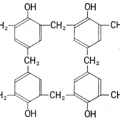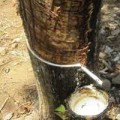INDEX

About liquid resin
The liquid resin is a resin that exists as a liquid at room temperature.
In ISO 554-1976 has defined as a range of 20 ℃ ± 15 ℃ (5 ~ 35 ℃) “cold”.
The temperature at which the melting of the resin is called “melting point”, but low melting point of the resin is equivalent.
There is an epoxy resin, urethane resin, silicon resin.
In addition, liquid resin, sometimes referred to as a pre-polymer.
There in a pre-stage to be a polymer, it is often liquid.
Prepolymer is an intermediate product that stopped the polymerization or condensation reaction of the monomer in a suitable place.
*Light Curing Resin, please refer to the next chapter.
Liquid epoxy resin
About the safety of the epoxy resin
Since the epoxy resin is also the type that cause health problems, and requires extreme caution in handling.
It is the main primary irritation and allergic dermatitis of the skin as a failure example but, nervous system disorders, liver disorders, depending on the type There is also a type of mutagenicity was observed.
Because there are many cases where the organic solvent and auxiliaries are blended, and confirmed it should be treated safely in each of the MSDS (Material Safety Data Sheet).
In dangerous goods classification of Japan’s Fire Services Act is a flammable substance that is classified as “specified flammable materials” or “fourth such third petroleum”.
Type of epoxy resin
The epoxy resin, it is the generic name of a thermosetting resin that can be cross-linked network of epoxy groups.
And the prepolymer before crosslinking networking, commercialization resin was subjected to thermal curing treatment by mixing the curing agent has also been referred to as both an epoxy resin.
Bisphenol A [2,2- bis (4-hydroxyphenyl – propane] The condensation products of epichlorohydrin (BPA type), or, is abbreviated as (bis-A type) epoxy resins, but is the first resin has been developed , it is even now accounts for about nearly 70% of the epoxy resin production volume.
Bisphenol A of BPA type from phenol and acetone, also, epichlorohydrin is synthesized from propylene.
Phenolic compounds such as novolac instead of bisphenol A, amines, there is also those using the carboxylic acids.
Cyclopentadiene and cyclohexene derivatives, and polybutadiene, a method of introducing an epoxy group using organic peracids in the unsaturated group, such as drying oil.
Epoxy resin There are products from liquid to solid by molecular weight.
By raw materials and production process, you can resin with different properties and BPA type resin.
Type of curing agent
Epoxy resin mechanical strength and chemical resistance by reacting with the curing agent is stable.
- Amine-based curing agent
- Acid anhydride-based curing agent
- Polyamide-based curing agent
- Anionic polymerization type curing agent
- Multi-functional curing agent
Urethane resin
And it is divided into the base resin and a curing agent liquid at room temperature, and then cured by polymerization by mixing and stirring the two.
Curing time is from a few minutes to about 10 minutes, after tomorrow curing before curing a transparent liquid will become opaque solid, such as beige, pink-white.
Viscosity is high, there because as such can not be gravity cast at room temperature and atmospheric pressure, others a large amount of volatile solvent is mixed to the commercial products.
Mixing of the volatile solvent is useful for improving the flow properties, but to allow the molding of gravity casting in a normal temperature and pressure, the solvent is volatilized over time from the solidified resin, the volume of the molded product is reduced and it will cause problems such as distorted in.
Also, urethane resin that contains a volatile solvent, can not be used to vacuum casting.
In the vacuum casting by reducing the pressure inside the mold, it is because the volatile solvent will boil.
Urethane resin of solvent-free, while the liquidity is required techniques such as low vacuum casting, molded product will have a relatively high degree of dimensional stability.
In modern times, non-xylene type obtained by removing the xylene that is harmful to the human body has become the mainstream.
Silicone resin
The silicone , with the main skeleton by siloxane bonds, is the generic name of an artificial polymer compound.
Ketone carbon atoms refers to a compound that was replaced with a silicon atom, it has been named from Silicoketone.
In general, “silicone resin” or it is often abbreviated referred to in the “silicone”, so caution is needed as confusing and “silicon” elements and non-consolidated.
Silicone oil is a straight chain structure molecule of the siloxane bond is 2000 or less.
Silicone rubber is a straight chain structure molecule of the siloxane bonds of 5000 to 10,000.
Room temperature vulcanization (RTV ) type generally are commercially available in a liquid state as a rubber, and then curing by polymerization reaction of the catalyst is added silicone.
There is one-part and two-pack type, a liquid rubber having reactive groups both in the rubber molecular chain terminal, the former reacts with moisture in the air, the latter rubber molecular chain by reacting the two components liquid extension, cross-linking is done.
It will be further classified into an addition reaction type and condensation reaction type depending on the type of reaction.
Molding method
- Gravity casting method: How is poured into a mold at room temperature and atmospheric pressure by the weight of the resin itself
- Top gate method: Casting opening is arranged (gate) to the upper mold part way pouring resin.
- Under gate method: Casting opening is arranged (gate) to the lower mold part way pouring resin.
- Vacuum casting method: The pressure was reduced been stomach type and resin in a vacuum vessel if it is determined a precise molded product, is pushed then back to atmospheric pressure method.
- Centrifugation method: To create a disk-shaped mold which separates the upper and lower, a method of spread after pouring the resin into the center every detail by centrifugal force to the resin by rotating the turn table.
Curing and degassing
The mass quickly that there is a high ambient temperature, the longer it takes to lower the curing.
Solidify masses soon as the amount is large, it takes time to cure and less.
To make products with no bubbles, you can clean product Lowering the viscosity is warmed a little.
If remains low viscosity without harden immediately, bubbles will disappear up in little by little surface.
When the short curing time, the bubbles will solidify together in as it is.
The degassing, is advantageous to low viscosity state has long lasting.
In other words, to make a clean product with no bubbles, a low viscosity state is long, is advantageous long curing time.
As of vacuum molding method, it is easier to deforming If the surface is at the vacuum vessel after molding a negative pressure.
Cause and solution of the curing time of contraction
- A resin that contains a solvent or water, the volume reduction of the volatiles will occur.
- In the resin that contains the bubble, the volume reduction of the degassing amount will occur.
- In general a difference occurs in the free volume after curing and before curing the thermosetting resin, the difference is contracted.
When the curing reaction is to proceed bridged structure state, the free volume hole, reducing the lead to a reduced molecular interval is reduced.
Epoxy resin is ring-opening reaction of the three-membered ring containing an oxygen atom occurs.
There tends to be greater the shrinkage number of epoxy groups per molecule is large. - Tips to make clean parts, utilizing the surface tension becomes beautiful finish when cured as to inject slightly more resin.
 HEAT-TECH Best Technology Online Shop
HEAT-TECH Best Technology Online Shop 










